Prediabetes Foods to Avoid: Take our Quiz to See How You're Doing

Key Takeways
Prediabetes is a health condition where your fasting blood glucose levels hover around 100 to 125 mg/dL. It affects millions worldwide, and according to the Centers for Disease Control and Prevention (CDC), more than one in every three American adults has it.
Someone is generally diagnosed with prediabetes when their blood sugar levels are higher than normal but not high enough to be considered type 2 diabetes. Still, just because prediabetes is not yet diabetes, doesn’t mean you should ignore it.
When someone is diagnosed with prediabetes, there is already a problem with glucose metabolism. According to the CDC, there is a higher risk of developing type 2 diabetes within five years of being diagnosed with prediabetes.

However, that is the case only if you don’t do anything to stop the progression of prediabetes to type 2 diabetes. With lifestyle changes such as healthy eating and increased physical activity, it may be possible to reverse prediabetes for some people.
Prediabetes often begins with insulin resistance. So it’s crucial to minimize your intake of foods that can cause a more significant glucose response and, in turn, a large insulin response.
Consider avoiding foods like processed grains, sugary beverages, and large portions of carbohydrate foods in isolation. Add more whole, balanced foods like non-starchy vegetables, brown rice, legumes, and other protein sources.
Of course, a healthy diet looks different for everyone. It's a good idea to consult a registered dietitian to find the best dietary exclusions and inclusions for your specific needs.
In the meantime, take a look at what foods you should consider avoiding and what you should consider including in your meal plan if you have prediabetes.
Why Should You Avoid Certain Foods When You Have Prediabetes?
If your diet includes trans fats, sugary drinks, and carbohydrates in isolation, you may want to consider making some changes.
If you’re wondering why, here’s the obvious answer: unhealthy dietary and lifestyle habits put you at a higher risk of several health conditions, including high cholesterol, high blood pressure, and heart disease.
If you have prediabetes, there’s a little more to it, and it has to do with something called insulin resistance.
What is insulin resistance? You can think of insulin as a key that lets glucose into your cells. Insulin resistance is when your cells start to become resistant to insulin. The key (the insulin) no longer works as effectively.
If your body is having trouble getting glucose into your cells, it can lead to more glucose staying in your bloodstream. Your pancreas starts to work on overdrive to release more insulin to overcome this and bring blood sugar levels back to baseline.
If you have prediabetes and eat a meal high in carbohydrates (processed carbs or sugars), your body works harder to get blood sugar levels back to baseline. It's a complex physiological process that can lead to type 2 diabetes. With prediabetes and insulin resistance, the first goal is to lessen the burden on your pancreas. It includes eating foods that do not produce a large glucose response.
The offending foods are typically high in carbohydrates like pasta, some bread (like white bread), white rice, potatoes, and processed foods like baked goods. Others, like sugary drinks and fruit juice, are high in sugar and easy to digest, which means they can cause a large amount of sugar to enter the bloodstream.
Take Our Prediabetes Quiz
Before we get into some of the foods you may want to avoid or limit if you've been diagnosed with prediabetes, let's see how much you know about this condition. Put your prediabetes knowledge to the test below!
Avoid or Limit These Common Breakfast Foods
Yes, some breakfast foods can put you at an increased risk of diabetes. It’s because breakfast foods, including but not limited to certain cereals, pancakes, and waffles, tend to be very high in carbohydrates.
While it’s okay to eat some of these foods in moderation, consider a few tweaks if you have prediabetes. Starting your day with a meal high in sugar can lead to a glucose rollercoaster, leading to sugar cravings. So, what’s the perfect prediabetes diet plan for breakfast? Here’s some tips:
Heavy Carbohydrate Foods

Yes, the pancakes, waffles, French toast, and donuts you love are high in carbohydrates and often made with white flour. In addition, some have syrup, fruit, or whipped cream. Another common carbohydrate-dense breakfast side is hash browns.
But you can get creative to find healthy alternatives. Make a whole grain or sprouted whole grain alternative, or use lower carb flours like coconut, almond, or cassava flour. Also, pair the food with a protein—if you want to have a pancake, consider limiting it to one pancake and eating it with some eggs. The protein can help slow digestion, leading to a more gradual release of glucose.
Sugary Breakfast Cereals
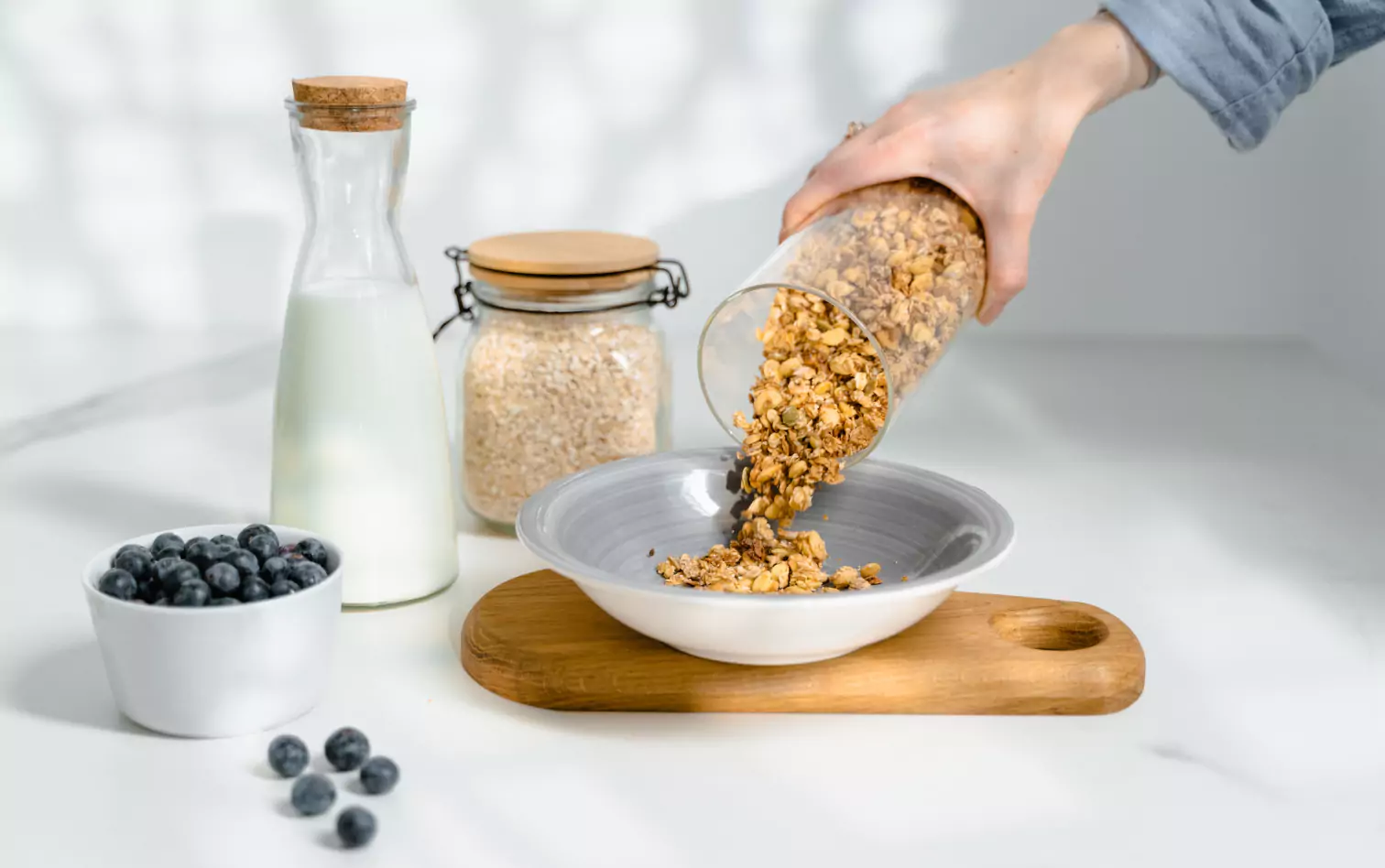
Sugary breakfast cereal is another food to avoid, including anything with marshmallows, chocolate, or brightly colored “pebbles.” Also, don’t be fooled by claims of low-fat, fiber-filled, whole-grain options. Always check the label and ingredient list to review how healthy your cereal is.
Look for things like added sugars. See whether whole grains are listed as the first ingredient or just added in with other grains, and keep added sugar to a minimum. A good rule of thumb is five grams or less of added sugar per serving (and even less if you’re aiming for a low-carb or ketogenic approach).
Even healthy cereals often contain carbs. Measure your portion size to see that you’re not eating too many carbohydrates from a giant bowl of cereal.
For people with prediabetes, a moderate carbohydrate approach is typically around 30 grams of carbs per meal, and that can be a good initial step in lowering carbohydrate intake. However, this study observed a better outcome in people with prediabetes consuming less than 50 grams per day or roughly 15 grams of carbohydrates or less per meal.
Pair it with protein, or switch to a cooked cereal like old-fashioned or steel-cut oatmeal. A half-cup of cooked oatmeal has about 15 grams of carbs and no added sugar. Add fruit, nuts, and maybe unsweetened Greek yogurt for a breakfast with fewer than 30 grams of carbs, protein, and healthy fat.
Sweetened Yogurt

Most plain yogurt does contain some sugar, but it naturally occurs from lactose. The sugar in one cup of plain yogurt might be around 12 grams, and one cup of Greek yogurt is five to eight grams. But most flavored yogurt is loaded with added sugar—some have as much sugar and fat as ice cream! Like breakfast cereal, checking the ingredient label to review the added sugar content is always a good idea.
Even though yogurt has protein (Greek yogurt has more than regular yogurt), the added sugar can easily be double or triple the amount of protein in grams. Many people think yogurt is a good choice for protein in the morning but neglect to look at the sugar content and how this may impact blood glucose levels.
The best choice is always going to be unflavored or plain yogurt. Greek yogurt is higher in protein and lower in lactose (natural sugar), so it’s always a good choice and better for those with lactose intolerance.
If you can’t stand unsweetened yogurt, try something with less sugar, like Siggi’s, an Icelandic yogurt. Another option is to mix some sweetened with plain yogurt or add berries to sweeten it without added sugars (although fruit still has naturally occurring sugar). Cinnamon is also an excellent choice for flavor and sweetness.
Avoid/Limit These Common Lunch Foods
It may be easier to eat lower-carb meals at lunch, but there are some things you may want to consider when choosing a lunch option if you have prediabetes. For instance, foods higher in sodium don’t cause blood sugar spikes but can be a risk factor for hypertension, which is associated with prediabetes and diabetes. This combination can also increase your risk of stroke and heart disease.
Processed Meats

Processed meats are high in sodium. So while they can be a good choice for protein, they may not be the best choice if you have prediabetes, especially if you’re at risk of developing high blood pressure.
For instance, a single slice of pastrami has around 300 milligrams of sodium. Most people with prediabetes are encouraged to consume 2000 milligrams (or less) of sodium, so you can see how the sodium from these foods can add up.
Try to avoid this one if possible. While picking processed meat, consider low-sodium choices lower in saturated fat, like roast turkey or lean roast beef.
Fast Foods

Fast food is notorious for being both higher in carbohydrates and sodium. A Big Mac, for example, has 45 grams of carbs and 1000 milligrams of sodium. If you add small fries and a small soda, you’re consuming another 70 grams of carbs and 220 milligrams of sodium.
That's 115 grams of carbs and 1220 milligrams of sodium! You're likely to see a significant sugar spike from this, and it's also more than half the recommended sodium intake in just one meal. It's not a great meal choice for someone with prediabetes.
If you find yourself eating at a fast-food restaurant, consider making healthier choices. For example, have the Big Mac in a lettuce wrap instead of a bun and skip the fries and soda.
Most fast-food places have nutrition facts listed online, so check that out in advance. At Taco Bell, for example, one Crispy Taco has only 13 grams of carbs and 300 milligrams of sodium.
Low Protein, High Carb Meals
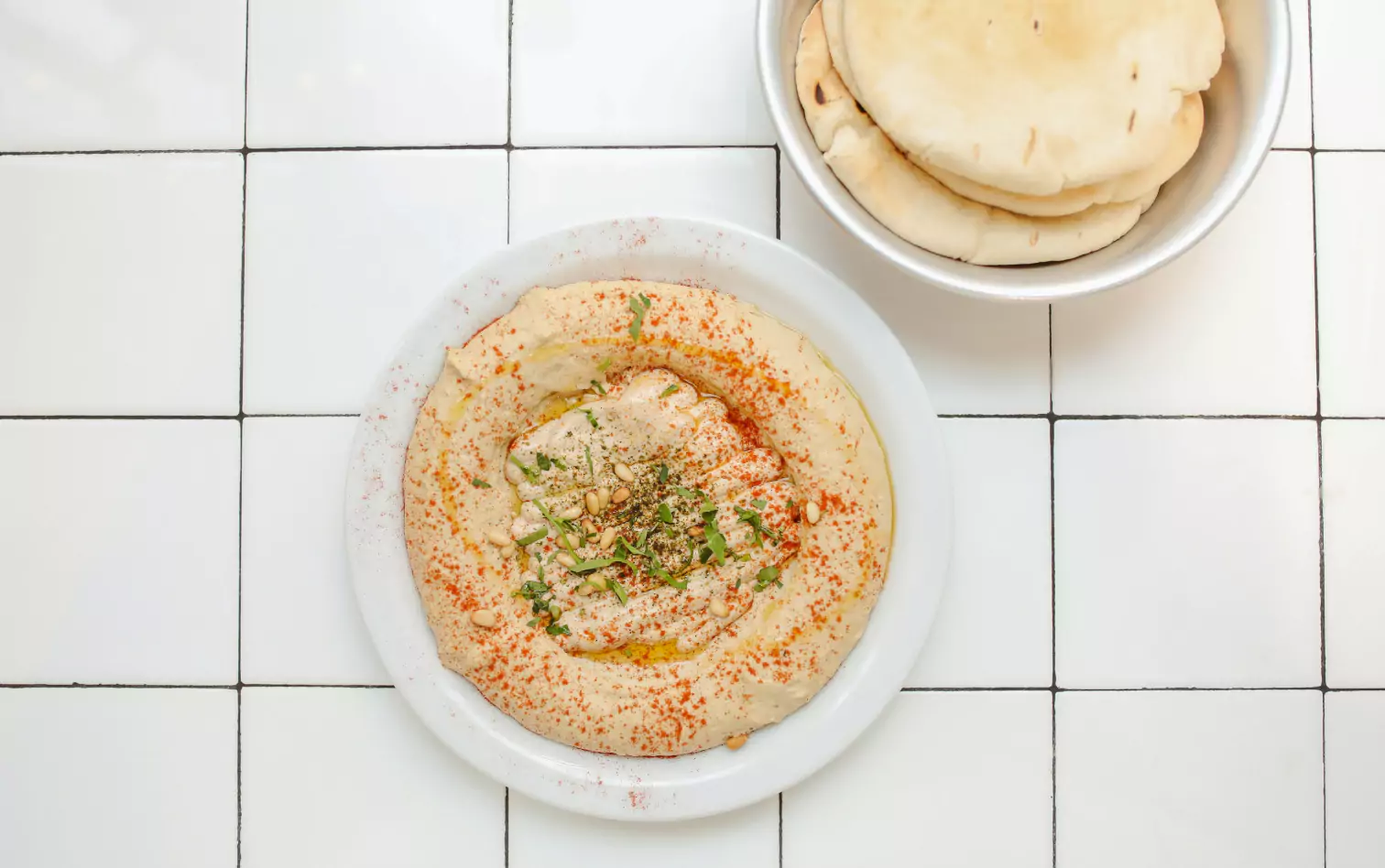
Some lunch options, like pasta meals or a wrap filled with hummus and veggies, are higher in carbohydrates and lower in protein. These meals are sometimes seen as healthy food options, but when a large tortilla has upwards of 60 grams of carbs, it can be easy to see how this may not be the best choice.
When choosing a lunch option, it’s a good idea to find one with a good amount of protein, like meat, eggs, fish, or tofu. Or, pick a combination of high-protein ingredients such as lentils or beans, nuts/seeds, and/or quinoa.
Just keep in mind that beans/lentils and whole grains like quinoa, while healthier options than refined grains, will still contribute some carbs that may or may not be as well tolerated by some people. Consider non-starchy options like a salad or bowl instead of a wrap or burrito to lower the carb content.
And as the American Diabetes Association suggests, add as many non-starchy veggies to your meal as possible. They help increase fiber without extra calories or carbohydrates. Also, consider heart-healthy fats such as avocado, olives, or nuts/seeds.
Avoid or Limit These Common Dinner Foods
Even if you don’t have prediabetes, it’s a good idea to make dinner your lightest meal of the day. And if you’re looking for what types of food to avoid regardless of what time you eat your dinner, here are a few:
Anything Fried
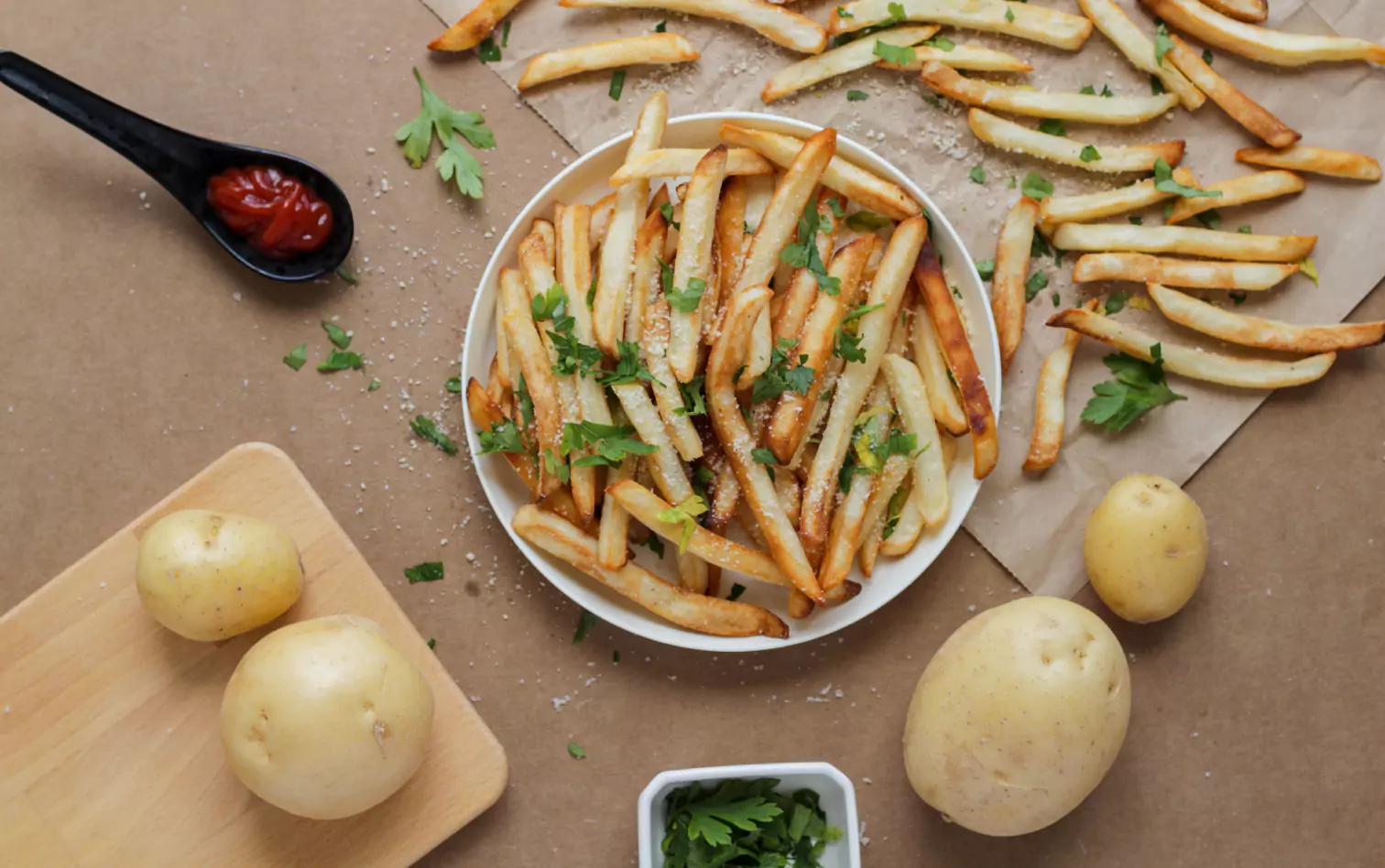
Remember that fried food often uses some form of flour or bread crumbs as a batter, which can be a hidden carbohydrate. In addition, fried foods are higher in sodium and some unhealthy fats like trans fats. They can increase inflammation, increasing your risk of developing diabetes and cardiovascular disease.
Your best option is to choose baked, roasted, grilled, or steamed over fried foods. And if you like the crispy fried feel to your food, consider an air fryer to get a similar texture without all the fat.
Pasta

Pasta is very carbohydrate-dense—a one-third cup of cooked pasta contains about 15 grams of carbs, so one cup is 45 grams. Most people quickly consume two to three cups worth at a time.
The good news is that there are healthier alternatives. Consider pasta made with lentils with more protein and lower carb content.
Pasta made from edamame is another option, with 25 grams of protein and only 19 grams of carbs per two ounces. Of course, you can always use zoodles (noodles made from zucchini), spaghetti squash, or shirataki noodles, all of which are great low-carb options.
Foods in Sugary Sauces

Most people know that ketchup, an American favorite, has a lot of added sugar. But did you know there’s likely sugar in everything from pasta sauce and Thai curry to Hoisin, Teriyaki, and barbecue sauce?
For example, one tablespoon of Hoisin sauce can contain about seven grams of carbohydrates and 5 grams of sugar. So if you have more than one serving, which is very easy to do, sugar can add up quickly.
Pick sauces that are lower in sugar or do not contain added sugar, like mustard, mayonnaise, hot sauces, or soy sauce. You can always find lower sugar or sugar-free versions of your favorite “sweet” sauces, often containing artificial sweeteners. As always, check the label!
Snack Foods to Limit/Avoid
Does your meal plan include three large meals a day or several smaller meals? Is snacking part of your lifestyle? If you get peckish between meals, picking the right snacks is essential. And if you have prediabetes, avoiding sugary, fatty, carb-laden snacks is best.
Here are a few more guidelines for healthier snacking.
Dried Fruit

Dried fruit is often considered healthy but can be high in sugar. It’s dehydrated fruit, so you need less of it to get the same amount of carbs. For instance, one-fourth cup of raisins has the same sugar as roughly one cup of grapes. Dried fruit, including dried cranberries and mangoes, also often have added sugar.
When it comes to dried fruit, focus on portion size, pick options without added sugar, and consider pairing it with a protein. Some trail mix with nuts, seeds, and dried fruit could be a good option. Adding a small amount of dried fruit to a salad can be a way to add flavor, too; just make sure the salad also contains a good protein option.
Processed Carbohydrates

Processed carbohydrate snacks include pretzels, crackers, cookies, and chips. These foods are often high in carbohydrates and lower in other nutrients like fiber, vitamins, minerals, and protein. Because of the salt or sugar content, they can be easy to overconsume.
While avoiding these snacks is best, pick tortilla chips made with cassava flour or baked potato chips to satisfy the occasional craving. Consider taking out a serving, placing it in a small bowl, and putting the container back in the cabinet. If you eat from the bag or box, you are more likely to overeat!
Sugary Drinks
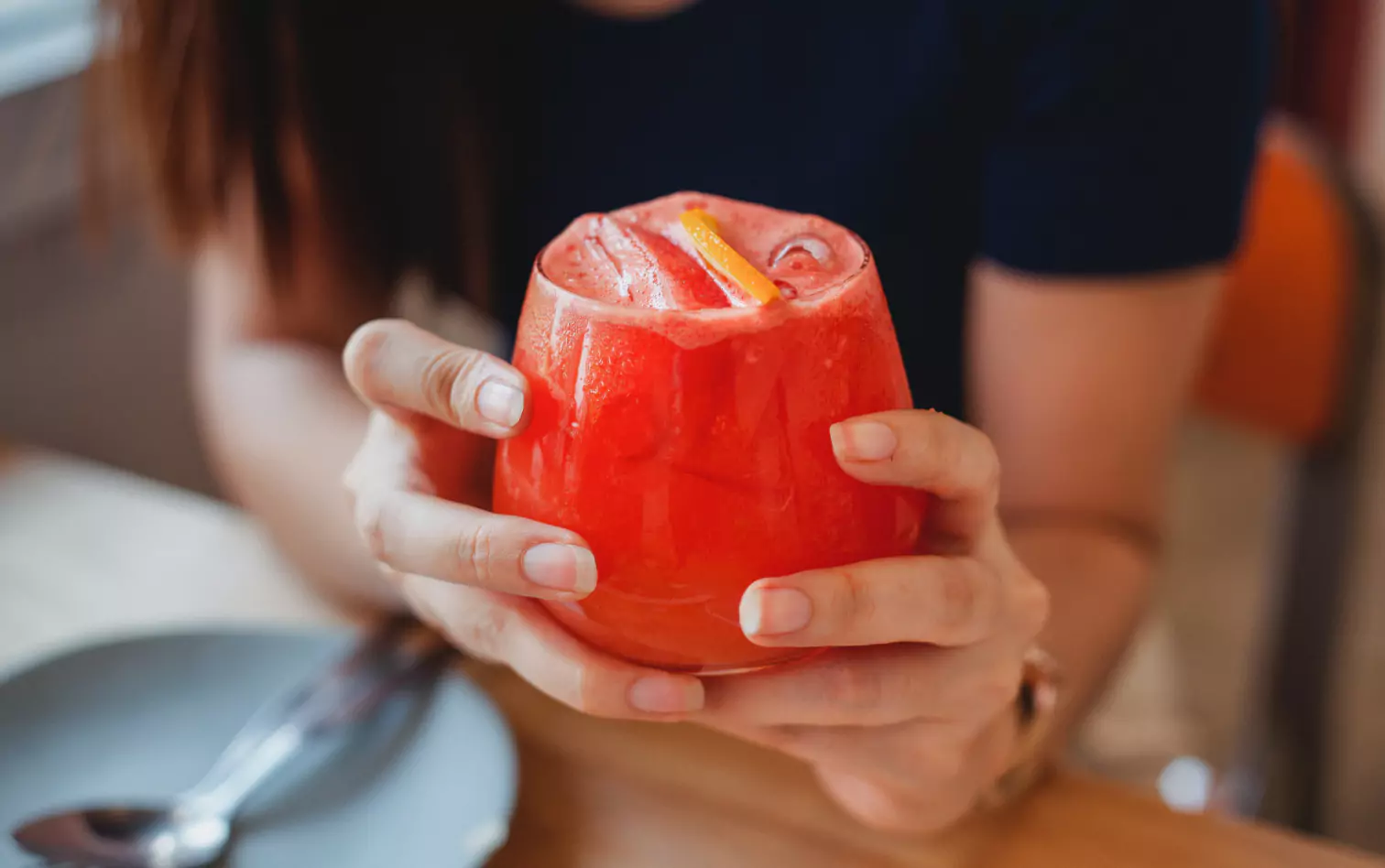
Sugary drinks include soda, sports drinks, and even some fruit juice. The American Heart Association recommendation for people without diabetes is that men consume no more than nine teaspoons or 36 grams of added sugar, and women consume no more than six teaspoons or 24 grams.
But a 12-ounce Coke has 39 grams or almost 10 teaspoons of sugar! Remember, everyone’s tolerance for sugar is different, and some people with diabetes and prediabetes may find they do better with even lower amounts of added sugar.
Sports drinks can also contain added sugar, some close to or as much as soda. And while you may think all fruit juice is healthy, it may have a lot of sugar, and Juicing can strip the fruit of its fiber and some other nutrients.
You may also consume too much, depending on how much fruit juice you drink. Remember that eight ounces of orange juice = two to three oranges. It’s easy to consume a glass of juice in a few minutes, but it would take longer to eat three whole oranges.
Dessert Items to Limit/Avoid
You may think a healthy diet means cutting out all desserts, especially if you have prediabetes or diabetes. Sugar can be challenging to include in your diet if you have these health conditions. Still, an informed choice can help minimize your response when you indulge.
Candies

Most candies are pure sugar with no nutrients. So, people with prediabetes and diabetes may need to avoid most types of candy altogether or limit it to small amounts.
Sugar-free candy can be an okay alternative if you tolerate artificial sweeteners, but they often contain sugar alcohol. Sugar alcohols can have a laxative effect for some people, so they may not be the best option for those with IBS or who are sensitive to polyols.
Cakes

No secrets here—cake is very rarely (if ever) a healthy food. Both the cake and frosting can contain a large amount of sugar and starch. But it’s pretty challenging to avoid it altogether, right? You could try to limit it to a special occasion treat or eat a tiny slice when you have a craving.
If you know you will be around it, consider eating a lower-carb meal that contains a good amount of protein ahead of time. The protein can help slow down digestion and may help prevent a more considerable spike in glucose when you do dig into dessert.
Pastries
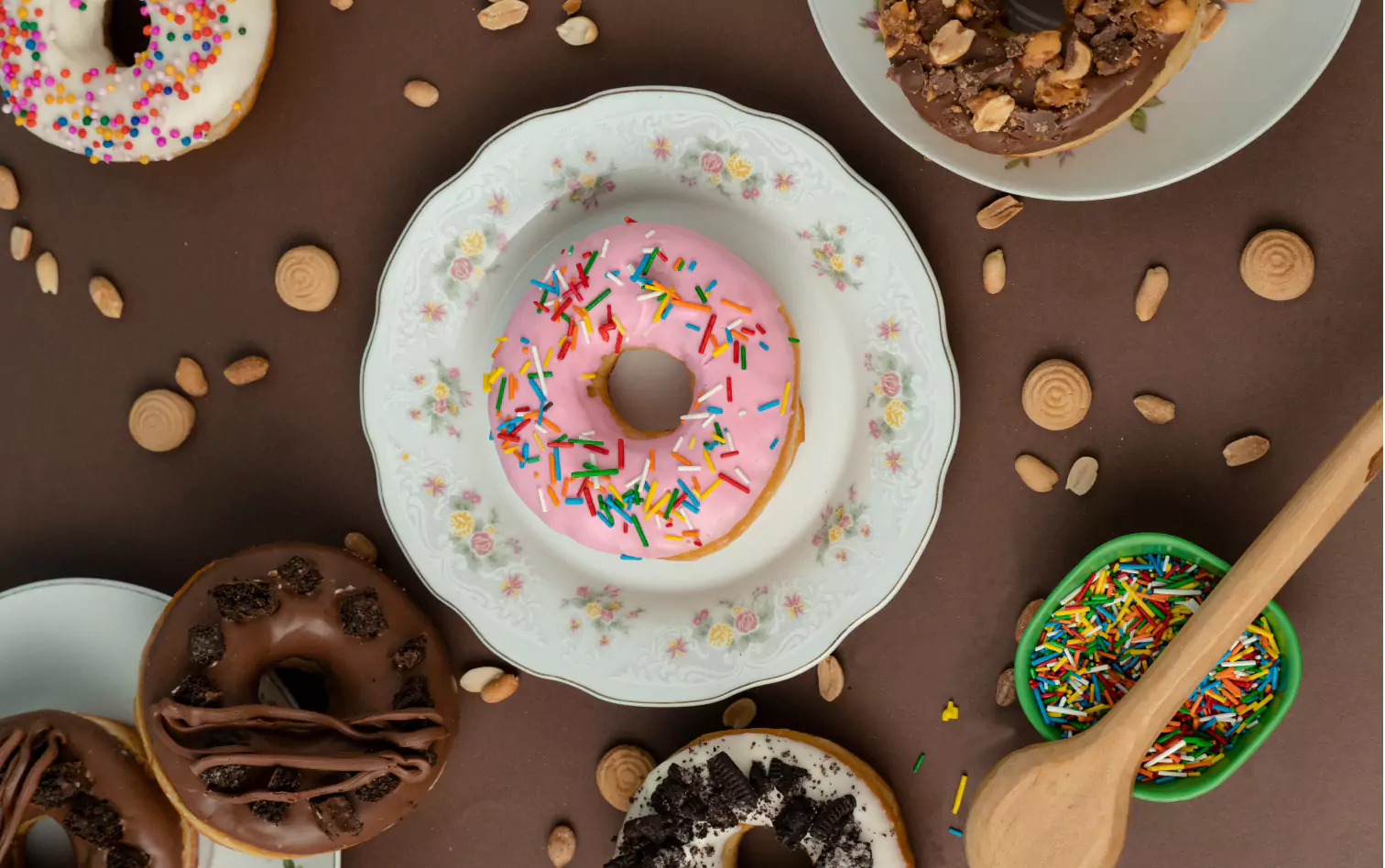
Pastries, like donuts, croissants, scones, or danishes, are breakfast food and dessert, so it’s tough to avoid them altogether. They’re similar to cakes in that they contain more sugar and starch, and some are higher in fat.
Combinations of higher fat and higher carbs may cause glucose to stay higher for longer periods and delay a healthy return to pre-meal glucose values. Consume them with protein if you want to indulge, or consider a half-portion to keep your glucose response to a minimum.
Find the right Nutrisense programto turn insight into progress.
Go Beyond Glucose Data with Nutrisense
Your glucose can significantly impact how your body feels and functions. That’s why stable levels are an important factor in supporting overall wellbeing. But viewing glucose isn't enough. Nutrisense, you’ll be able to learn how to use your body's data to make informed lifestyle choices that support healthy living.
One-to-one coaching
Sign up to access insurance-covered video calls to work with a glucose expert: a personal registered dietitian or certified nutritionist who will help tailor your lifestyle and diet to your goals.
Monitor and measure what matters
With the Nutrisense CGM Program, you can monitor your glucose with health tech like glucose biosensors and continuous glucose monitor (CGM)s, and analyze the trends over time with the Nutrisense App. This will help you make the most informed choices about the foods you consume and their impact on your health.
Find your best fit
Ready to take the first step? Start with our quiz to find the right Nutrisense program to help you take control.

Heather is a Registered and Licensed Dietitian Nutritionist (RDN, LDN), subject matter expert, and technical writer, with a master's degree in nutrition science from Bastyr University. She has a specialty in neuroendocrinology and has been working in the field of nutrition—including nutrition research, education, medical writing, and clinical integrative and functional nutrition—for over 15 years.


.webp)

